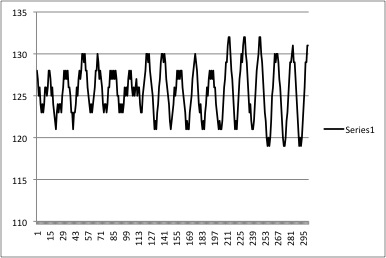CS074: The Digital World
In-class Exercise with Binary Editor
1. If you have not already done so, download the Binary Editor from the
course website into the course folder on your computer. Make sure
it is saved with with the file name BinEd.jar. You should also
download the test file telltale.txt that I have provided: This is
an ASCII-encoded text file of the creepy horror story "The Tell-Tale
Heart", by Edgar Allan Poe.
2. Launch the program by double-clicking on the icon with title
BinEd.jar.
3. The first screen you see (the Save/Load screen) invites you to load
a file. Click on this button, then use the file chooser dialog
box to navigate to where you saved telltale.txt, and select it.
You will be automatically switched to the Binary Editor screen.
At the right, you see the contents of the file, byte by byte, displayed
in a number of different formats: decimal, hex, binary and, if the byte
is the ASCII encoding of a character, text. Observe that
nonprinting and 'whitespace' ASCII characters like space, tab, and line
feed (advancing to next line) are displayed using abbreviations.
If a byte is encountered that is not the ASCII encoding of a character,
then question marks will be displayed. This does not occur for
the text file you are looking at, but is typical behavior when you
examine other kinds of files, like images.
The left half of the screen contains a number of controls for modifying
the bytes in the file, as well as the total number of bytes,
which in this case is 11176. There are two ways to change the
file contents: by writing a kind of algebraic formula, or by
using the controls Modify..., Average...,Copy/Delete. Formulas
give more flexibility, but are somewhat harder to learn. Since we
will be doing something very like the formula-writing later when we
write programs, for the Binary Editor we will stick to the three
control buttons just named.
4. Click on the Modify button and look at what comes up. Let's
experiment with some of these controls: Suppose, for some reason
or another, you wanted to change every occurrence of the lower-case
letter 'e', to #. We need to know the ASCII encodings for
'e', and '#'. We can look these up in the table provided
in the course notes, and get the answers (in decimal) 101, and 35,
respectively. So we use the controls to 'Set all cells with value in
range 101 to 101 to 35', and click 'Apply'. You can see the effect
clearly in the right-hand column.
5. This operation does NOT alter the saved copy of 'The Tell-Tale
Heart' on your computer's hard disk. To save your changes, you
must click on the Save/Load tab, click 'Save As Binary File', and
select a name to save the chnged file under. I suggest that you
keep the original version and save the changes as something like
'telltale2.txt'. Do this now, and then open the file you just saved in
the Text Editor to examine the changes.
6. Now let's undo the changes by clicking 'Revert to Original', and
let's try something new. We are going to encrypt the text in the
file by using a crude method. We replace every occurrence of the
letter 'a' by 'b', 'b' by 'c', etc., and similarly for the upper-case
counterparts. We replace 'z' and 'Z' by 'a' and 'A',
respectively. How do we use the controls in the Binary Editor to
do this? This is a multistep process: An obvious answer is
to start with 'increase all cells with values in the range 65 to
89 ('A' to 'Y') by 1, and then proceed to handle the lower-case
letters, and then the z's. But this will not work! What is
the right way to do this?
7. Now go back to the Save/Load screen and load the file
'flute.wav'. We will talk at some length about how
audio is encoded in computers. For now you should just be aware
that the bytes in this file (after the first 40 or so) represent
measures of amplitude, or signal strength, taken at intervals of
1/11025 sec. If you plotted some of the sample values, they would
look like this:
8. Now switch to the Play As Sound screen and click Play.
(This should be fun in the class.) This plays back the sample values at
11025 samples per second, adjusting the volume in accordance with the
byte value.
9. How can we modify the file to make the sound louder? You
can try to do this by adding a positive integer onto all the sample
values, and also by multiplying all the sample values by, say,
1.5. Try both of these.
10. How can we make the sound play faster? Try selecting
every second sample, using the Average control.
11. How can we simulate a change in the sample rate? (Fewer
samples per second.) Try averaging every pair of successive
samples, using the Average control.

